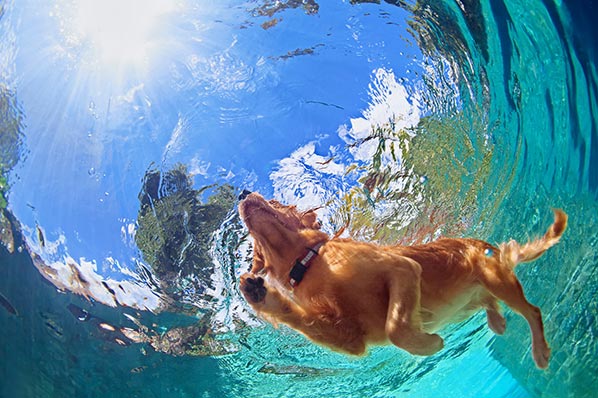Test Their Ability
If you’re unsure of your dog’s skill level, a pool with a temperature between 80 and 87 degrees is a great place to introduce them to swimming. “Start in shallow water and let your dog take a few strokes to the steps,” says Mary Burch, PhD, director of the Canine Good Citizen program at the American Kennel Club. Gradually back up into deeper water as your dog continues swimming. Always direct them to the pool’s stairs when exiting. While not all pups take to the water, some just need a few lessons to master their doggy paddle.
Invest in a Life Jacket
Senior dogs and short-legged breeds aren’t typically strong swimmers, so give them the option of floating. “A vest makes swimming a little easier and can help if they get tired,” says Kate Griffin, a certified canine swim coach at Water Bark Wellness in Camden, ME. Choose one with handles, like the Outward Hound PupSaver Ripstop Dog Life Jacket (from $25), to be able to effortlessly lift a pooch out of the water.
Beware of Hazards
If permitted, allow your dog to swim in the ocean or a lake or river, but never when warnings about strong currents are in effect. Avoid blue or blue-green algae, which can be toxic, and watch out for slippery areas where they enter the water.
Reschedule Meals
It’s fine for you to dive in after chowing down, but the same may not be true for your dog. Deep-chested breeds, like Great Danes, may develop bloat if they swim after eating. “As with any kind of exercise,” says Griffin, “you shouldn’t feed your dog two to four hours before swimming.”
Carry Drinking Water
Try to keep your dog from ingesting any of the water they swim in. Salt water can lead to dehydration, while stagnant water from a lake or pond can house parasites like giardia, which causes diarrhea. If your dog accidentally takes a gulp, quickly guide them to dry land and always have fresh, cool H2O handy for them to drink.
Photo: Bicho_raro/Getty.

